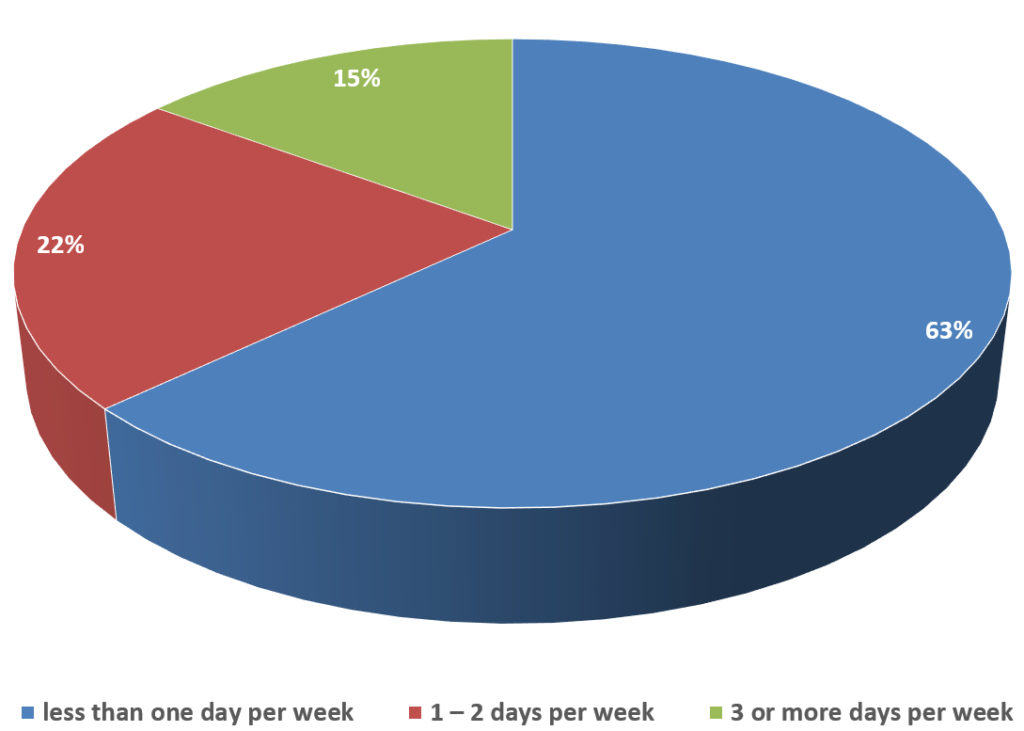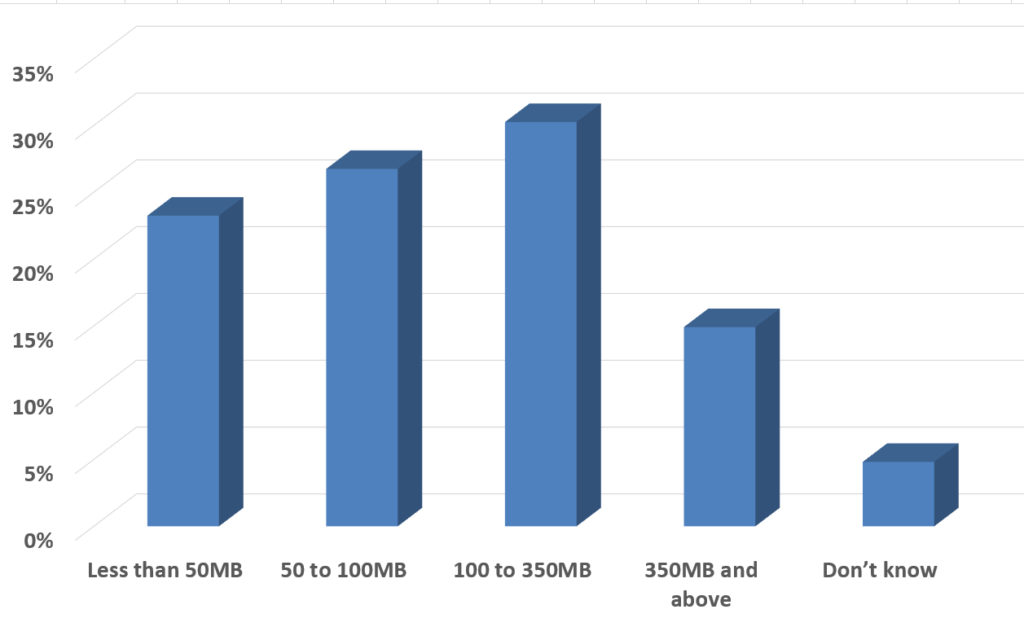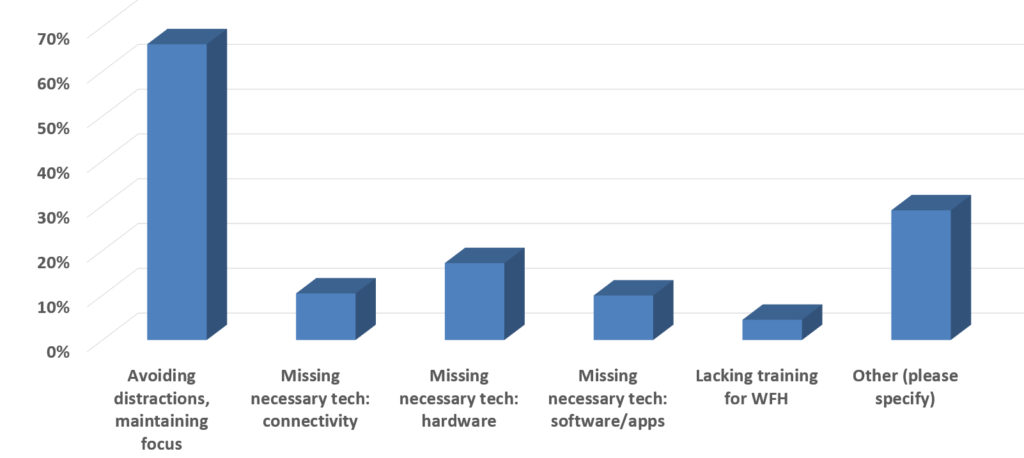
TechBeat Working from home survey: unexpected, hugely successful
There can be no doubt that the COVID-19 pandemic is one of gravest threats faced by the world in recent times. In Ireland, it has seen dramatic impacts across social, commercial and governmental spheres.
En masse, the workforce began to move home, with many functions that were never envisaged for the model suddenly being operated as they had never been before.
Innumerable surveys have been conducted and released about those moves and the experiences around them. However, Ireland’s IT professionals are more accustomed to enabling and supporting working from home (WFH) than actually doing it. TechBeat, in association with eir Business, determined to track and quantify this unprecedented swing from operations centres and offices to home for the Irish IT pro, helping to understand the challenges, impacts and potential benefits for when some semblance of normality may return.
Conducted in April, 230 respondents were very expressive in their commentary.

(Image: eir Business)
The extent of the impact of COVID-19 public health measures can be seen from the opening questions. Firstly, 94% of respondents said they were now working from home, with just 3% working in their normal business premises, and 3% unfortunately, not working at all.
In general, before the public health measures, less than a quarter (22%) worked from 1-2 days per week, with just 15% working from home for 3 or more days a week, leaving almost two thirds (63%) who would have worked from home for less than a day a week on average.
Furthermore, when the public health measures are lifted, more than a third (38%) still expected to work from home for less than a day a week on average. Those who expected a day or two per week rises to 40%, with 22% expecting to work from home for 3 or more days a week.

These figures demonstrate, quite clearly, that Irish IT professionals are almost entirely office based, with many not working from home regularly at all. This clearly has implications for work life balance, childcare and general wellbeing.

Many old arguments about which functions can and cannot be accomplished remotely have been firmly debunked amid this crisis, and it appears that the world of IT has not been immune to the effects. Hopefully, this will prompt greater discussion and latitude among organisations across the island, to facilitate more flexible working, to ensure staff wellbeing, as well as increasing the ability to attract and retain staff.
Clearly, this crisis has made many people realise the time lost in commuting, and the benefits of having a more home-focused approach to working. Even as many struggle with childcare where two primary carers might be working from home, many have also come to realise the true value of time spent with loved ones and children, begging many questions as to what such time is worth, both in terms of remuneration and wider considerations.
The open comments about future intentions to work from home were overwhelmingly positive, with confident assertions that issues of viability and trust were finally addressed. Many also commented on the absurdity of long commutes, in light of the WFH experience.
Much in the same way that workers rights and gender equality issues were unavoidable after previous global pandemics and crises, so the working from home genie will never go back in the bottle.
Tools and tech
Getting into some detail on working practices off site, just less than half (49%) of respondents said they use a virtual private network (VPN) to connect to work resources, with a further 24% saying they did so sometimes. Slightly less (23%) said they did not use a VPN at all, with a few (3%) don’t knows. A comment on this question highlighted that there are now many alternatives for secure connections to work resources, from encrypted SD-WAN to cloud and SaaS services that the need for dedicated VPN-based services has waned. Overall, the impression was of a high degree of awareness of the need for secure connections.
Next, the question was asked as to what kind of collaboration platforms, if any, were being used. Unsurprisingly, just 5% said they did not use a collaboration platform. By far the lead platform in use was the Microsoft Office 365/Teams/Skype for Business stack (67%) followed by Zoom (39%), Google G Suite/Hangouts (26%), Cisco WebEx (21%), Slack (11%), and Confluence (4%), though Facebook Workplace and Flock were on less than 1%. Under the other category (12%), WhatsApp, GoToMeeting and some proprietary solutions were mentioned.
Collectively, 95% of IT pros use a combination of these collaboration tools to be productive, indicating a high degree of task enablement, further pressing the message of remote not meaning unconnected.
However, this result was tempered somewhat by the fact that just 15% of respondents were on an internet connection of 350Mbs or more. Almost a quarter (23%) were on 50Mbs or less, with slightly more (27%) on 50 to 100Mbps, and 30% on 100 to 350Mbps. Just 5% did not know the speed of their connection.

In general, the country’s internet connection infrastructure has stood up remarkably well under the current unprecedented level of demand. Not only has a workforce gone home to work, but children have been logging on to class assignments and virtual learning spaces, and others have enjoyed everything from group workouts and cooking lessons to language courses and how to cut one’s own hair. That is all before the likes of streaming services such as Netflix get a look in, or indeed a launch, as with the Disney Plus service.
However, the fact that 80% of the country’s IT professionals are working with less connectivity than your average half rack in a data centre is also telling.
Productivity
A later question asked about productivity. More than a third (34%) said their productivity had improved and the comments section cited lack of interruption as a strong recurrent theme for this. Some 39% said productivity was about the same, and less than a quarter (23%) said it was slightly less. Just 4% said productivity was much less. Some cited the fact that they would normally be comfortable with home working, but having to do so in a full house, often with less space or no space dedicated, had impacted their ability to be productive. Others, such as those who would normally have had a field role, said that they had been reassigned to new duties in support, and so were grappling with new conditions which affected their productivity.

The survey also asked about whether respondents had varied working hours due to working from home. The majority (52%) said they had, against 48% who said no. However, the comments section in other questions cited working hours that corresponded to commute times, varied duties and other factors as mitigating circumstances. There were few indications of overly extended working hours, but rather an adaptation to the circumstances.
Irrespective of one’s own working practices, it is the people with whom we regularly do business that have a major impact on what can be done. Almost half (47%) of respondents said their experience was about the same in trying to contact and interact with people. Some 16% said it was easier. More than a third (36%) said it was harder.
With a strong majority (63%) finding it the same or easier to contact and interact with those they normally do business with, the broad experience of WFH is a positive one. Again, the comment section reveals that it is decision finality, rather than people availability, that has proved harder to achieve. However, another recurrent theme was people’s willingness to make the best of the situation by making themselves more available through various means of communication, working around issues such as childcare, and helping others.
Challenges
When asked specifically about the challenges in working from home, a clear two thirds said avoiding distractions and maintaining focus was the top challenge, followed by a lack of necessary hardware (17%), a lack of connectivity (10%) and a lacking of necessary software and applications (10%).

Again, this is a largely positive outcome. With low exceptions, Ireland’s IT professionals have been able to decamp at short notice, the majority having never done so before, and work remotely effectively.
The ‘Other’ category, here was a significant proportion (29%) and listed themes such as a lack of dedicated space, or such spaces being usurped by partners, housemates, children or others. The collective experience of an entire household having to do so much more from home has had a greater impact than the technical infrastructure.
Other gripes were not having suitable furniture to support long term WFH practices, with chairs in particular, being singled out for unsuitability for sustained use.
However, also mentioned within this ‘Other’ comment section was also no real challenges at all.
Policies
The survey asked whether the respondent’s organisation had an existing WFH policy. Almost half (49%) did, with similar (44%) saying no. In the ‘Other’ section, a more qualified ‘yes’ was given by many, where they said certain sections of their organisations had a policy, such as field or sales staff, whereas the likes of legal did not. Others said their policy covered working remotely, but not necessarily from home.
Given this was conducted when some people had already been under lockdown conditions for some weeks, the survey asked if respondents thought that home working could improve work-life balance, with an option to provide a qualifying comment.

An overwhelming majority (82%) said they did, compared to just one in 10 who said no, with the rest undecided or qualifying.
One comment said “I have gained so much time back in my day, I have more time for exercise and spending time with my family, even if I am doing longer hours in work. The time I have saved on travel has really benefitted me. I can sleep a bit longer, exercise and still do a full day’s work, in the time I was spending getting to and from work as well as in the office. My resting heart rate has moved from an average of 68 to an average of 54 since working from home!”
While some comments expressed a pang for missed colleagues and water cooler exchanges, there were further qualified positive answers for WFH under more normal conditions.
This particular metric is one of the most telling of all. When combined with the number of respondents who normally work from home in this contingent, the benefits of WFH are clear, in terms of effective use of time and the rewards that brings both for business and personally. While people have undoubtedly woken up to the benefits, it will be up to employers and personnel to work out how best to implement new practices to ensure security, productivity and flexibility in what is now an unquestionably beneficial practice.
Service provider performance
Connectivity service providers also fared well in the survey.
Overall, close to three quarters (70%) of respondents rated their provider as good or excellent overall, with fixed network service and general reliability (72%), bandwidth (68%) and mobile network service (62%) all faring well. Understandably, customer service did not fare quite so well (49%), but under the circumstances this may be taken as a positive, given the unprecedented surge in demand. When taken with the good or excellent rating for reliability and bandwidth, this has to be seen as a very strong performance from the connectivity providers as whole, from the big names such as eir Business, Vodafone, Three, and Virgin Business, along with more focused providers such as BT, Magnet Networks, Imagine, Sky, Fastcom, Digiweb, Orion and Skytel.
Commentary
In a departure from the usual form for TechBeat surveys, and in an effort to allow people to be more expressive under the unusual circumstances, respondents were asked for their general insights and experiences of the COVID-19 related WFH situation.
The broad experience is one of positivity, adapting to new circumstances as best one can, and helping others to do the same. There was a widespread sense of understanding and latitude for the fact that people were enduring difficult circumstance and doing their best.
A tiny selection of comments below represents some of the echoed themes throughout.
One respondent put it succinctly by saying: “It is the new norm and it is essential to get used to it.”
But within this general attitude, there are those for whom the whole experience is new and takes some adjusting: “As a public service worker, it will take some time to [become] accustom to.”
The social isolation comments were common too, with many echoing the sentiment: “The physical social interaction is definitely missed but otherwise everything that I could do in the office I can do remotely.”
The thread of supporting those who might things difficult was consistent: “It’s pretty much the same but with increased workload to help others who are not used to working from home and helping them set printers, get into conference calls. If we have a network hardware failure on-premises it is difficult to diagnose and fix as we have no-one onsite currently to reboot equipment, provide troubleshooting feedback.”
Some find it more difficult than others: “Non-technical end users have found managing the necessary technical tools more challenging. They would generally avoid things like online conferencing facilities and would prefer to read and review hard copy documents than reading on-screen.”
The old chestnut of micro-managing managers has perhaps moved on a stage too: “Working from home is a great way for staff to learn self-management. As a manager, it is evident if some individuals are less productive, and this can be addressed. Employers need to trust their employees and provide resources and supports to enable home working.”
However, there were some qualifying insights too, that are worth bearing in mind: “It is important for all companies to recognise that this is not normal working from home, this is sheltering at home during a pandemic while trying to work. While lessons should be learned from this experience, they must be learned in that environment.”
Service view
From the view of a long standing service provider and technology partner, Martin Wells, managing director, eir Business, also sees the positives, despite the decidedly abnormal circumstances.
“Employees working from home are reporting increased productivity and ability to focus on detailed work without distractions. Employers too are realising that many of their perceived challenges of having a remote workforce are surmountable. It’s telling that almost two-thirds of respondents expect to continue to work from home at least 1-2 days per week once public health measures are lifted,” said Wells.
“Unquestionably, the advanced communication and collaboration tools available today have made working from home easier and more productive than it would have been even five years ago. Our respondents are using a broad selection of applications that support video calls, which are proving critical for maintaining face-to-face contact. All of these tools are powered by the faster broadband speeds that most workers now have access to. In fact, over 70% of respondents are experiencing speeds over 50Mbps.”
Wells is also unequivocal about the impact of this experience for Irish IT professionals in a post COVID-19 world.
“Prior to the COVID-19 pandemic, working from home wasn’t commonplace in Ireland, with 63% of respondents saying they did not work from home previously. However, once we emerge from the current public health measures, we expect to see a changed work environment where businesses adopt a hybrid model of home and office working. This will blend the benefits of home working with the in-person contact that is still so important to business,” concluded Wells.
Conclusions
There can be no doubt that every part of our world will be changed in some way by this global pandemic experience. However, what has also become clear from the collected experiences and insights of Irish IT pros and technology industry workers who have responded to this survey is that the home and remote working experience is overwhelmingly positive and will change attitudes and expectations for when public health restrictions have been rolled back.
When more people have issues with space on the kitchen table and the suitability of chairs then they do with data access, connectivity or availability of colleagues, then the old arguments against home and remote working are simply dismissed.
Despite their ability to implement them, Irish IT professionals appear to have been one of the least likely cohorts of Irish workers to take advantage of WFH provisions. This is will change.
However, what will also emerge from this is a rebalancing of effort, as many realise they may simply be losing too much of their precious time commuting or simply sitting in an office somewhere when it is not only not strictly necessary, and in some cases counterproductive. There will be implications for commercial property across the board. But what has not been found lacking, thankfully, is the either the supporting infrastructure, or the suite of services and applications needed to be effective wherever. This bodes well not only for the future development of the country, but also for the immediacy of recovery expected when restrictions are lifted.







Subscribers 0
Fans 0
Followers 0
Followers